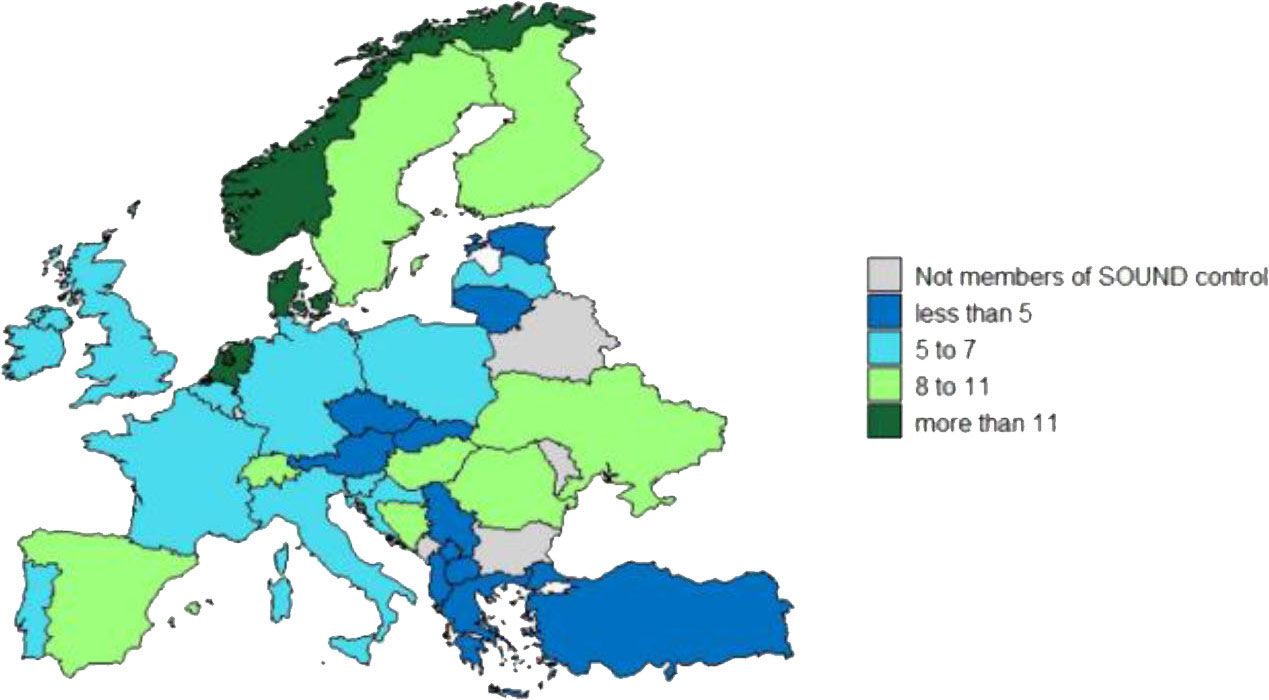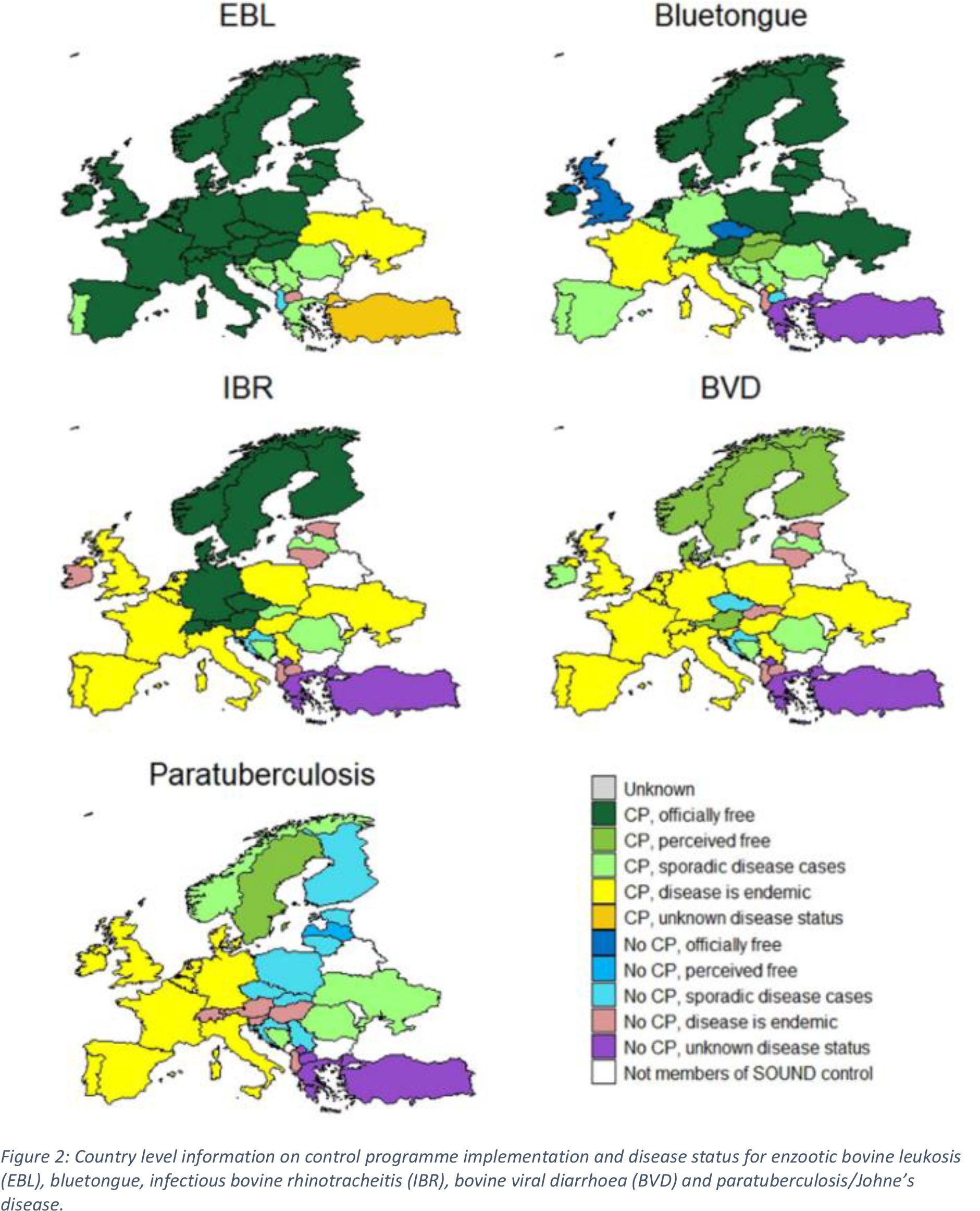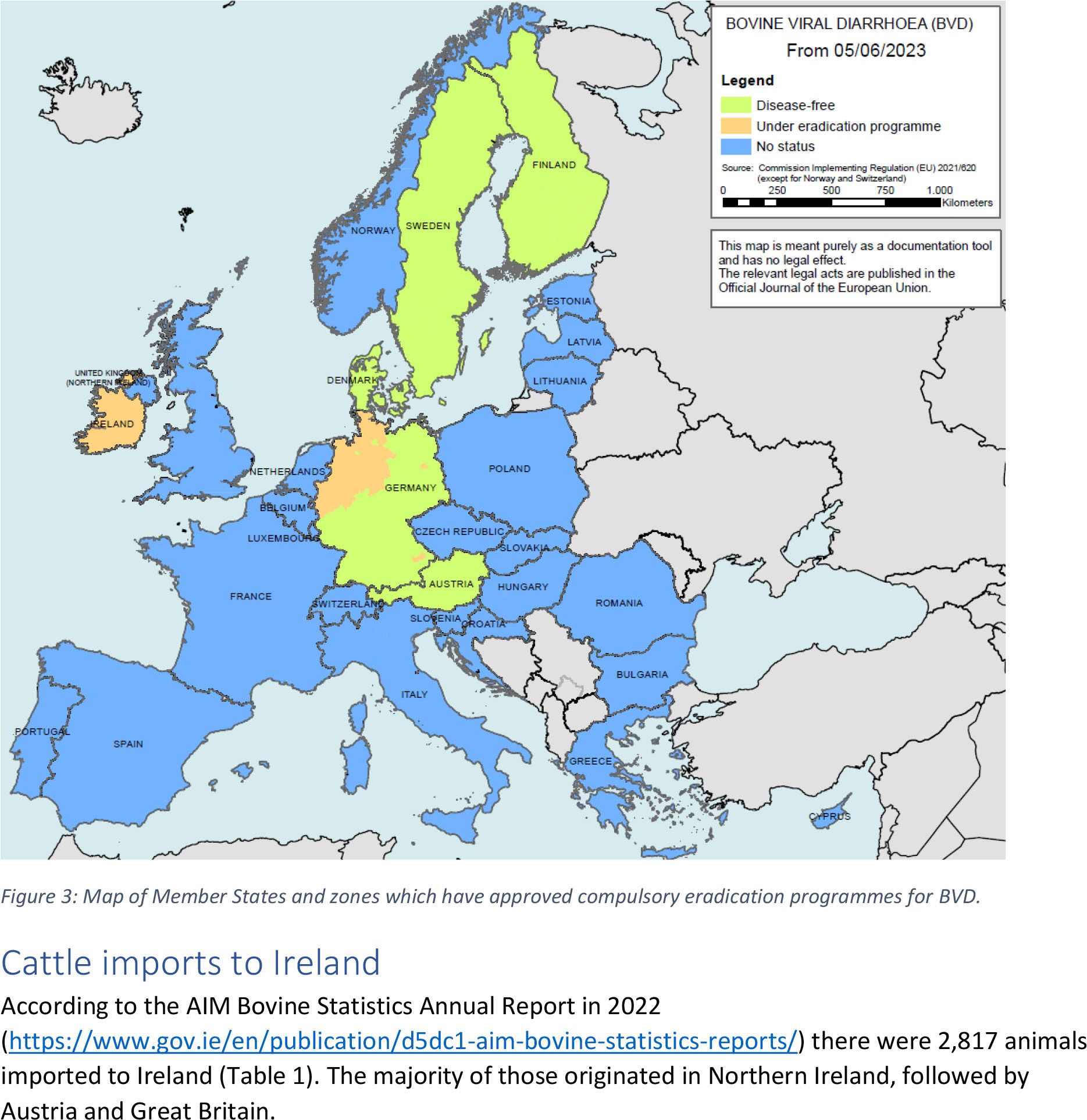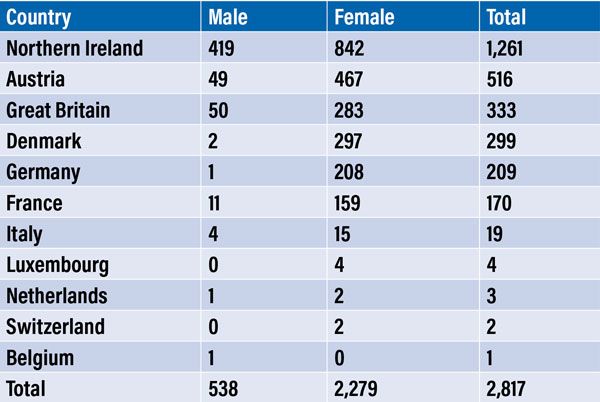Cattle disease control programmes in Europe
Maria Guelbenzu LV PhD MRCVS, BVD Programme Manager, AHI, provides an overview of cattle disease control programmes in place in Europe in 2020
Animal disease control programmes (CPs) provide benefits for animals, farmers, the industry and consumers through improving animal health and welfare, decreasing antibiotic use, and, in the case of zoonotic diseases, improving the safety of animal products. In addition, it is now acknowledged that improving animal health can help cut greenhouse gas (GHG) emissions. Although their implementation involves associated costs for testing, administrative work etc, these are generally considered to be outweighed by the benefits.
The objectives of this article are to give a summary of the cattle disease control programmes in place in Europe as collated by the SOUND control COST action in 2020; to improve awareness of those programmes so that vets can help clients to make informed decisions regarding importing animals from other countries/regions; and finally, to improve understanding on the progress made by other countries in controlling endemic diseases of cattle.
SOUND control
“Standardising output-based surveillance to control non-regulated diseases of cattle in the European Union” (SOUND control) is a COST action (CA 17110) that aimed to harmonise the results of surveillance and control programmes for selected cattle diseases to facilitate safe trade, and to reduce the economic impact and improve overall control of infectious cattle diseases (https://sound-control.eu/). This COST action connected more than 100 members from different fields (including veterinarians, epidemiologists, economists, statisticians, sociologists and policy makers) from 33 European countries. The first working group within the action aimed to identify cattle diseases with no or limited regulation at European level for which CPs are in place and to describe the characteristics of these CPs.
The summary of CPs for cattle diseases in Europe in 2020 presented here is based on Hodnik et al., (2021) which provided a comprehensive overview of the disease status and control efforts at the end of 2020 for selected cattle diseases with no or limited regulation at European level, for all 33 European countries that participated in the SOUND control project.

Figure 1: Number of non-EU regulated cattle diseases with control programmes in countries participating in Standardising output-based surveillance to control non-regulated diseases of cattle in the European Union (SOUND control).
Cattle disease control programmes
In total, partners from 33 countries (giving a 100 per cent response rate) provided information. The median number of CPs in place per country was six (range one to 13). The number of controlled non-regulated cattle diseases per country is shown in Figure 1. Enzootic bovine leukosis (EBL), Bluetongue (BT), infectious bovine rhinotracheitis (IBR), bovine viral diarrhoea (BVD), anthrax, paratuberculosis or Johne’s disease (JD), salmonellosis, bovine genital campylobacteriosis, leptospirosis and trichomonosis were controlled by the greatest number of countries. Note that, throughout the results, section percentages may not sum to 100 per cent. This reflects the fact that some countries have not answered all the questions for their CPs in the survey, therefore some information is missing.
EBL was the most frequently controlled disease (CPs in 31 countries) and the most countries were officially free or perceived free of EBL (22 countries). The country with CPs for the greatest number of diseases, was Denmark (n = 13). Scandinavian countries were free of the most diseases. Norway tops this list, with officially, or perceived, free status for 12 diseases. Most CPs were implemented at national level (86 per cent) and applied to all types of cattle (75 per cent). The others applied specifically to beef or dairy cattle or breeding animals. Most CPs were compulsory (67 per cent). Most programmes were funded by the government (47 per cent), followed by private (27 per cent) and co-funded programmes (22 per cent).
Eradication and control programmes predominate, while surveillance programmes are the most common in countries which have eradicated, or never had, a specific disease and conduct surveillance to prove freedom of disease.
Countries that have eradicated diseases like EBL, BT, IBR and BVD have implemented CPs for other diseases to further improve the health status of cattle in their country. Austria, Denmark, Finland, Norway and Sweden have an officially free or perceived free status for these four diseases and have on average more CPs in place (n=9) compared to six in countries that are not free.

Figure 2: Country level information on control programme implementation and disease status for enzootic bovine leukosis (EBL), bluetongue, infectious bovine rhinotracheitis (IBR), bovine viral diarrhoea (BVD) and paratuberculosis/Johne’s disease.
Enzootic bovine leukosis
The country level information on CP implementation (31 CPs) and disease status for EBL is displayed in Figure 2. Most CPs are applied at national level to all types of cattle and are compulsory (n = 28). The vast majority are funded by the government (n = 26). The aims of the CPs vary between eradication and surveillance. Twenty-two countries (out of 31 with CPs) are free from the disease and most regions of Portugal are also free apart from one with sporadic cases. The disease is endemic in two countries, sporadic in eight countries and Turkey reported an unknown status for the disease.
Bluetongue
The country-specific information for BT (27 CPs) is displayed in Figure 2. All CPs in place are compulsory (except in Romania which has a voluntary CP) and all are implemented at a national level and mostly government-funded (n = 20). The most common type of CPs are surveillance programmes (n = 16). Seventeen countries are officially free or perceive themselves as free from the disease. Ten countries have sporadic cases, four an endemic status and two countries report an unknown status.
Infectious bovine rhinotracheitis
The data for IBR (24 CPs) are presented in Figure 2. Fifteen CPs are compulsory. Most are implemented at a national level (n = 19) (Italy, France, Portugal, Spain, and Ukraine have regional CPs). Funding for these comes from a variety of sources [private (43 per cent), government (35 per cent) or co-funded (22 per cent)] and most aim to control the disease. The disease is endemic in most of the countries, except for eight that are officially free (eleven have additional EU guarantees for cattle trade). Italy has regions that are officially free of the disease. Five countries have sporadic disease occurrence and three report an unknown status.

Figure 3: Map of Member States and zones which have approved compulsory eradication programmes for BVD.
Bovine viral diarrhoea
The country level information for BVD (23 CPs) is displayed in Figure 2. There is a large variety of CPs in place for BVD targeted at breeding animals (9 per cent), dairy cattle (9 per cent) or all types of cattle (82 per cent). While some of the BVD CPs reported are compulsory, a proportion are voluntary (62:38 per cent). In some countries, there is a mixture of compulsory and voluntary CPs depending on region or cattle type e.g., mandatory for dairy and voluntary for non-dairy. The majority are implemented at national level (77 per cent) and are privately funded (50 per cent). However, there are also some co-funded programmes (27 per cent) (i.e., funded by government and private stakeholders). The majority of the programmes aim at controlling or eradicating the disease (n = 18). Five countries perceive they are free, while for the others the disease occurs sporadically (n = 6), is endemic (n = 19) or has an unknown status (n = 3).
The new Animal Health Law (AHL), implemented since 2021, sets out the requirements for recognition of BVD programmes and BVD-freedom at EU level for the first time. An application for recognition of the Irish BVD programme was submitted in 2022 and the programme was officially approved on July 18, 2022 (Figure 3). This approval is a key milestone for the programme and a prerequisite for applying for recognition for freedom. In addition, the AHL includes details of requirements in terms of BVD testing and certification for the movement of animals within the EU and from a third country. Currently, animals must not be vaccinated against BVD and either originate from a country/territory free from BVD or they test virus negative and comply with a series of further requirements before entering Ireland. Guidelines for requirements for the import of live bovine animals can be found in https://www.gov.ie/en/publication/2c845-bovine-animals/.
Paratuberculosis/Johne’s disease
The member countries’ information for JD (15 CPs) is displayed in Figure 2. Around two-thirds of the CPs in place are voluntary (71 per cent). Most apply to all types of cattle, one (Sweden) only applies to beef and four (Belgium, Denmark, Ireland, Netherlands) only to dairy cattle. Bosnia and Herzegovina has a CP for breeding bulls. Sweden has a CP for beef cattle as the country is perceived free and imported beef cattle are considered a risk for disease reintroduction. In the Netherlands, non-dairy herds can also participate in a voluntary paratuberculosis CP. Most CPs are implemented at the national level except five (France, Portugal, Spain, Ukraine, and Germany), which are regional. In terms of funding, there is an equal share of programmes privately funded (n = 6) and co-funded (n = 6), while Germany’s and Norway’s CPs are completely funded by the government. The majority of programmes aim to control the disease (n = 9), while four countries have surveillance programmes. Two countries (Latvia and Sweden) are perceived to be free from the disease, twelve have sporadic cases, and four reported an unknown status. In other countries, the disease is endemic.

Cattle imports to Ireland
According to the AIM Bovine Statistics Annual Report in 2022 (https://www.gov.ie/en/publication/d5dc1-aim-bovine-statistics-reports/) there were 2,817 animals imported to Ireland (Table 1). The majority of those originated in Northern Ireland, followed by Austria and Great Britain.
Discussion
Most of the countries that participated in the study had CPs for EBL, IBR, BVD, BT and anthrax, while other diseases were controlled by only a few, or even a single country. Countries that had eradicated diseases like EBL, IBR and BVD have implemented CPs for other diseases to further improve the health status of cattle in their country.
During the SOUND control COST Action, a large amount of information and data was produced by members of SOUND control, all available through the website (https://sound-control.eu/). The range of information and data includes: all peer-reviewed publications, reports, a handbook describing the cattle disease control programmes in the partner countries, and a YouTube channel with many videos on monitoring and surveillance and related topics. There is also an R Shiny app with information on the disease status of endemic cattle diseases across Europe (https://shiny.fli.de/ife-apps/SOUNDcontrol/). The app helps users search for specific diseases and compare control programmes in different countries.
Conclusion
Improving awareness of CPs in place and cattle disease statuses in European countries could be useful for farmers and veterinary authorities when evaluating the risks associated with importing live cattle from those countries. The control of non-EU regulated cattle disease is very heterogeneous due to the wide variation in disease prevalence and the corresponding variation in CP design resulting from the need for each country’s CP to be tailored to its specific disease context.
Hodnik, J. J., Rogić, Ž. A., Alishani, M., Autio, T., Balseiro, A., Berezowski, J., Carmo, L. P., Chaligiannis, I., Conrady, B., Costa, L., Cvetkovikj, I., Davidov, I., Disps, M., Djadsjovski, I., Duarte, E., Faverjon, C., Fourichon, C., Frössling, J., Gerilovych, A., … Santman-Berends, I. M. G. A. (2021). Overview of cattle diseases listed under category C, D or E in the Animal Health Law (AHL) for which control programmes are in place within Europe. Frontiers in Veterinary Science, 8(July), 1–13. https://doi.org/10.3389/fvets.2021.688078
1. Animal disease control programmes typically:
A. Improve animal health and welfare
B. Decrease antibiotic use
C. Improve the diseases’ impact on productivity
D. All of the above
2. The most common cattle disease controlled within the responding countries was:
A. BVD
B. EBL
C. IBR
D. Paratuberculosis
3. Most of the animals imported into Ireland in 2022 originated from:
A. Netherlands
B. Northern Ireland
C. Denmark
D. Great Britain
4. When importing an animal to Ireland, regarding BVD:
A. The animals must be tested for BVD virus
B. The animals must not be vaccinated
C. There are additional guarantees relating to BVD which are applicable to the certification of cattle now that Ireland has an approved programme
D. All of the above
ANSWERS: 1D; 2B; 3B; 4D.
















